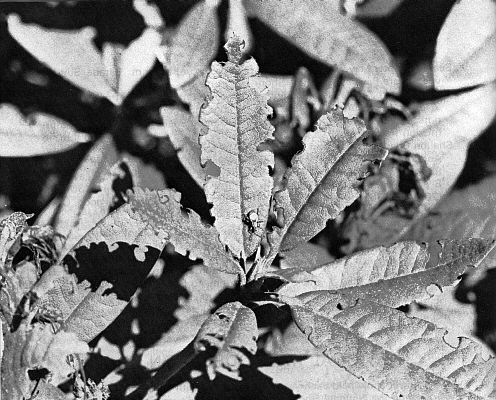QBARS - v31n2 Rhodies No Longer Nibbled Nightly
Rhodies No Longer Nibbled Nightly
Reprinted from the Fall, 1976 (Vol. 23, No. 2) Oregon's Agricultural Progress, a publication of the Agricultural Experiment Station, Oregon State University, Corvallis
and from personal correspondence to the Quarterly Editor

|
| Oregon State University Photo |
Agricultural research has moved into the backyard rhododendron garden. Oregon State University entomologists Richard Clarke and Harry Bell have been taking a close look at the obscure root weevil, long the nemesis of the backyard rhododendron grower. "Some gardeners probably have this little fellow chewing on their plants and don't know what's happening," said Clarke. "It's inactive during the day and feeds at night so all most people see is the damage." Their Agricultural Experiment Station research centered on this particular species of root weevil which notches the leaf edge of many plants, most notably the rhododendron.
The pest which is native to Oregon has menaced strawberry growers for years. First DDT was a control agent, then Aldrin and Chlordane. "Now that all these chemicals have been either suspended or banned, the strawberry growers have a new chemical that works well on root weevil," said Clarke. "The only problem is, it is much too toxic for backyard use and it's doubtful if it will be registered for rhododendrons. "This means the insect can easily walk into a yard and attack rhodies," said Clarke. "The obscure root weevil doesn't fly, but you would be surprised where it can walk if left unchecked."
Since most earlier root weevil research pertained to large acreages of strawberries, the work on root weevils in the backyard had to start at the beginning: where do they lay their eggs and where do they over-winter? "At first we found the immature stage over-wintering on the roots as was traditionally thought," Clarke said. "But then we found that some of the insects also over-winter as adults. "This meant that in addition to the traditional egg-laying period of August to mid-October, there is also a short egg laying period in May," said Clarke.
Feeding begins on the foliage in early May. This is caused by adults which have "over wintered" in rhododendron gardens. The feeding damage is very light because of the cool conditions and the low number of weevils present. In mid-June, the new generation of adults emerges from the soil and begins feeding on foliage. From July 1 through September the heaviest feeding on foliage occurs. The suggested control interval is from July 1 to Sept. 30. Homeowners may want to begin in early June if they feel they are getting significant early damage to some varieties.
The egg laying period is from July 15 to October 15 (roughly). These eggs hatch into larvae (grubs) in the soil, which feed on roots from late summer until the next June. So, during the winter, there are larvae in the soil feeding on roots and there are some adults hiding in various locations attempting to survive the winter. Low numbers of adults do survive as mentioned above.
Bell and Clarke also made another significant discovery. There is a parasitic fly found in local pockets of the Willamette. It represents a new species of parasitic Diptera (flies). The parasite belongs to the Family: Tachnidae of the Order: Diptera. Taxonomists are currently evaluating the specimens sent by Bell and Clarke to the National Museum, Washington, D.C.
Since it is a new species, nothing, of course, is known about the fly. Observations by the two scientists indicate that adult weevils are "attacked" by the adult flies which lay eggs on the side (thorax) of the weevil. The eggs hatch and the maggot (young parasite fly) enters the weevil through one of the breathing holes (spiracles). The maggots develop by feeding within the abdomen of the weevil in the area of the ovaries, apparently destroying the weevil's ability to lay eggs. Most of this attack apparently takes place in the late summer and fall.
"Much work is needed to see if the parasite does provide control of weevil populations and to see if it has any potential as a biological control weapon against the obscure root weevil and possibly other species such as the black vine weevil, Oiiorhynchus sulcatus, " said Clarke.
